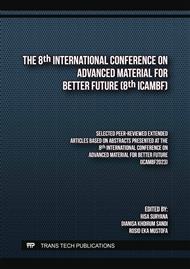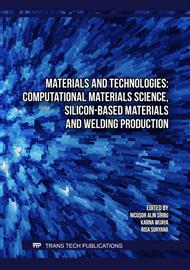[1]
Y. Arianti and B. Oktavia, "Optimization of Nitrate and Nitrite Anions Adsorption on Modified Silica using Batch Method," J. Phys. Conf. Ser., vol. 1940, no. 1, p.012042, 2021.
DOI: 10.1088/1742-6596/1940/1/012042
Google Scholar
[2]
W. Begum et al., "A Comprehensive Review on The Sources, Essentiality and Toxicological Profile of Nickel," RSC Adv., vol. 12, no. 15, p.9139–9153, 2022.
DOI: 10.1039/D2RA00378C
Google Scholar
[3]
M. M. Lazar, C.-A. Ghiorghita, E. S. Dragan, D. Humelnicu, and M. V. Dinu, "Ion-Imprinted Polymeric Materials for Selective Adsorption of Heavy Metal Ions from Aqueous Solution," Molecules, vol. 28, no. 6, 2023.
DOI: 10.3390/molecules28062798
Google Scholar
[4]
B. Pornchuti, B. Pongpattananurak, D. Sutthiard, and P. Singtothong, "Adsorption of Copper, Nickel and Chromium Ions Using Silica Aerogel Synthesized by Ambient-Pressure Drying and Modified with EDTA," IOP Conf. Ser. Mater. Sci. Eng., vol. 778, no. 1, 2020.
DOI: 10.1088/1757-899X/778/1/012133
Google Scholar
[5]
A. Azimi, A. Azari, M. Rezakazemi, and M. Ansarpour, "Removal of Heavy Metals from Industrial Wastewaters: A Review," ChemBioEng Rev., vol. 4, no. 1, p.37–59, 2017.
DOI: 10.1002/cben.201600010
Google Scholar
[6]
Z. Kheshti, K. Ghajar Azodi, A. Altaee, and M. R. Kheshti, "High-Gradient Magnetic Separator (HGMS) Combined with Adsorption for Nitrate Removal from Aqueous Solution," Sep. Purif. Technol., vol. 212, p.650–659, 2019.
DOI: 10.1016/j.seppur.2018.11.080
Google Scholar
[7]
B. M. Al-shehri, A. E. R. S. Khder, S. S. Ashour, and M. S. Hamdy, "A Review : The Utilization of Mesoporous Materials in Wastewater Treatment," Mater. Res. Express, vol. 6, no. 12, 2019.
DOI: 10.1088/2053-1591/ab52af
Google Scholar
[8]
A. Bilgiç and A. Cimen, "RSC Advances Removal of Chromium (VI) from Polluted Wastewater by Chemical Modification of Silica Gel with 4-acetyl-3-hydroxyaniline," RSC Adv., vol. 9, no. 64, p.37403–37414, 2019.
DOI: 10.1039/C9RA05810A
Google Scholar
[9]
N. Bheel, S. L. Meghwar, S. A. Abbasi, L. C. Marwari, J. A. Mugeri, and R. A. Abbasi, "Effect of Rice Husk Ash and Water-Cement Ratio on Strength of Concrete," Civ. Eng. J., vol. 4, no. 10, p.2373, 2018.
DOI: 10.28991/cej-03091166
Google Scholar
[10]
S. Hastuti, Nuryono, and A. Kuncaka, "Synthesis and Characterization of L-Arginine Modified Silica by Sol-Gel Method Prepared Rice Hull Ash," IOP Conf. Ser. Mater. Sci. Eng., vol. 509, no. 1, 2019.
DOI: 10.1088/1757-899X/509/1/012135
Google Scholar
[11]
Buhani, Narsito, Nuryono, and E. S. Kunarti, "Amino and Mercapto-Silica Hybrid for Cd (II) Adsorption in Aqueous Solution," Indo. J. Chem, vol. 9, no. 2, p.170–176, 2009.
DOI: 10.22146/ijc.21525
Google Scholar
[12]
N. D. Suzaimi, P. S. Goh, and N. A. N. N. Malek, "Modified-Nano-Adsorbents for Nitrate Efficient Removal : A Review," J. Appl. Membr. Sci. Technol., vol. 23, no. 2, p.65–81, 2020.
DOI: 10.11113/amst.v23n2.161
Google Scholar
[13]
S. Hamoudi, A. El-Nemr, and K. Belkacemi, "Adsorptive Removal of Dihydrogen phosphate Ion from Aqueous Solutions Using Mono, Di- and Tri-Ammonium-Functionalized SBA-15," J. Colloid Interface Sci., vol. 343, no. 2, p.615–621, 2010.
DOI: 10.1016/j.jcis.2009.11.070
Google Scholar
[14]
S. C. W. Sakti, D. Siswanta, and Nuryono, "Adsorption of Gold(III) on Ionic Imprinted Amino-Silica Hybrid Prepared from Rice Hull Ash," Pure Appl. Chem., vol. 85, no. 1, p.211–223, 2013.
DOI: 10.1351/PAC-CON-12-01-02
Google Scholar
[15]
M. R. Oliveira et al., "Amine-Modified Silica Surface Applied As Adsorbent in The Phenol Adsorption Assisted by Ultrasound," Chem. Eng. Commun., vol. 206, no. 11, p.1–16, 2019.
DOI: 10.1080/00986445.2019.1615467
Google Scholar



